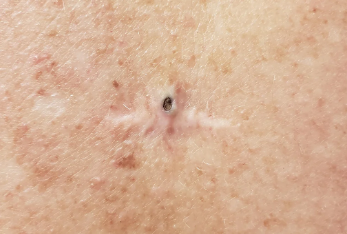Dilated Pore of Winer (Giant Blackhead) - a benign skin condition characterized by a giant open comedon. ICD-10 code: L73.9
According to some sources, the condition is more common in women than in men, by a ratio of 3:1, and occurs between the ages of 23 and 90 (most commonly in the 40-50 age group). Other sources suggest that it's more common in white males between the ages of 20 and 40.
The etiology and pathogenesis of this disorder are unclear. It is not associated with acne. One theory is that it is a benign tumor of the pilosebaceous complex with follicular differentiation, while another theory is that it is an infundibular cyst. Some authors consider it a variant of comedonal nevus. Predisposing factors may include a history of cystic acne and/or chronic intense sun exposure.The condition presents as a firm nodule or flat papule 2 to 15 mm in size, occasionally larger, with a skin-colored, white or yellow-white appearance and a central round or oval keratinous plug of dark color. When the plug is removed (either by squeezing or spontaneously), a thick white substance containing keratin is extruded, creating a deep pit that gradually refills over several weeks. The surrounding skin appears normal, with no signs of inflammation or thickening. Cases of a halo phenomenon, where a depigmented ring appears around the lesion, have been described.
A single lesion is usually observed, although multiple lesions may occur. The most common sites are the face, neck, and upper trunk, especially the back. Rare cases have been reported on the ear canal, eyelid, and vulva. The disease is chronic and typically asymptomatic. Complications such as inflammation or secondary infection may occur if attempts are made to squeeze or traumatize the lesion. Isolated cases of squamous and basal cell carcinoma and trichoblastoma arising in dilated pores have been reported.- Pilar sheath acanthoma
- Trichofolliculoma
- Comedonal Nevus
- Epidermoid cyst
- Favre-Racouchot syndrome
- Steatocystoma

